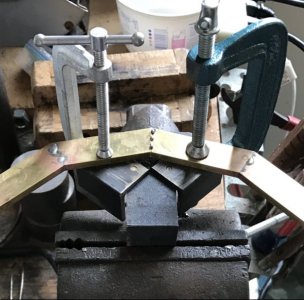- Joined
- Apr 24, 2016
- Messages
- 17
I need to silver solder brass to brass. Will the solder also attach the brass pieces to the steel jig holding the brass pieces in place?
Twelve brass pieces are to be connected end to end in the shape of a dodecagon. They need to be accurately located and clamped in place. I am planning to make a steel jig for this purpose. The jig consists of a flat square plate as the base with a flat disk (diameter equal to the inscribed circle of the dodecagon) bolted to the base. The brass will be laid around this disk. Holes will be drilled and tapped on the base for clamping the brass pieces. Consequently, the brass will rest on the steel when soldering. The acidic flux will probably pit the steel. Anything else I need to look out for? I have only minimal experience soldering and previously have been able to hold the parts at a distance from the soldering action. The way I silver solder is as follows: the brass pieces are clamped about 2 or 3 thousandths apart and fluxed, two or three tiny pieces of solder are placed on the joint, and the brass is heated on both sides of the joint with a propane torch until the solder flows into the joint.
I don't want to buy the steel (1/4" X 10" X 10" base and 1/4" X 8" X 8" disk) for the jig ($50) until I am sure this method will be successful. A different jig approach making one joint at a time was not accurate enough to ensure the final two ends would meet appropriately. Thanks for any and all suggestions.
John
Twelve brass pieces are to be connected end to end in the shape of a dodecagon. They need to be accurately located and clamped in place. I am planning to make a steel jig for this purpose. The jig consists of a flat square plate as the base with a flat disk (diameter equal to the inscribed circle of the dodecagon) bolted to the base. The brass will be laid around this disk. Holes will be drilled and tapped on the base for clamping the brass pieces. Consequently, the brass will rest on the steel when soldering. The acidic flux will probably pit the steel. Anything else I need to look out for? I have only minimal experience soldering and previously have been able to hold the parts at a distance from the soldering action. The way I silver solder is as follows: the brass pieces are clamped about 2 or 3 thousandths apart and fluxed, two or three tiny pieces of solder are placed on the joint, and the brass is heated on both sides of the joint with a propane torch until the solder flows into the joint.
I don't want to buy the steel (1/4" X 10" X 10" base and 1/4" X 8" X 8" disk) for the jig ($50) until I am sure this method will be successful. A different jig approach making one joint at a time was not accurate enough to ensure the final two ends would meet appropriately. Thanks for any and all suggestions.
John

